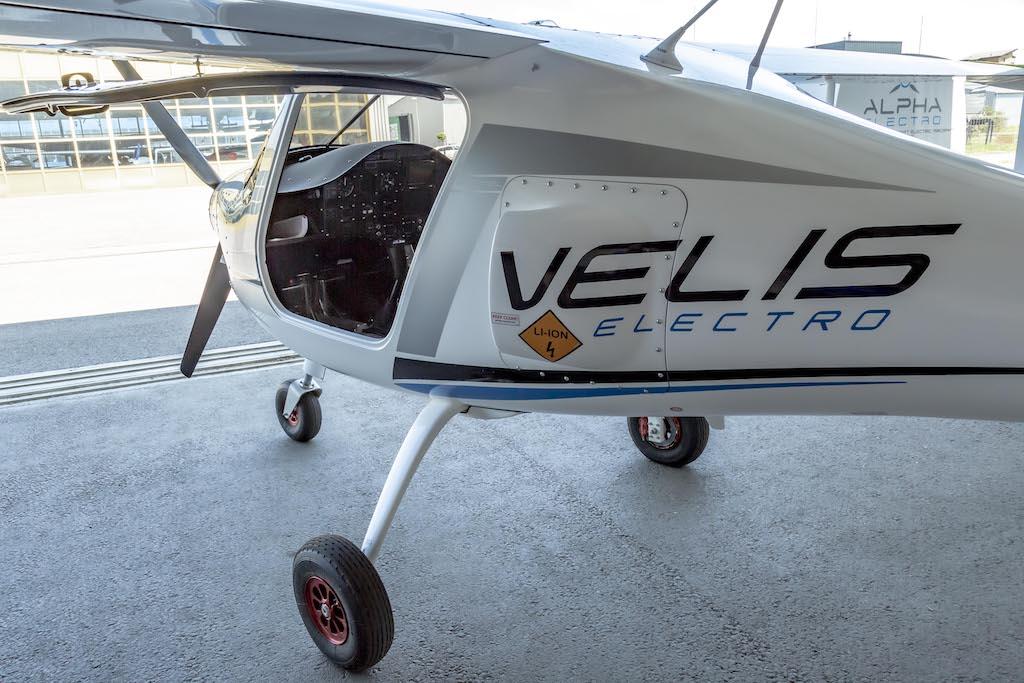
The Pipistrel Velis Electro is the first type-certified electric aircraft.
“The grand challenge of our time in aviation is carbon emissions and global warming, and if we don’t address it in every possible way, aviation will be moot,” Erik Lindbergh, grandson of Charles Lindbergh, told attendees of the European Business Aviation Convention & Exhibition (EBACE) in May.
The gravity of this situation spurred the Forever Flight Alliance—supported by The Lindbergh Foundation, X Prize Foundation, The Prince Albert II of Monaco Foundation and the NBAA—to incentivize efforts worldwide to decarbonize aviation.
While impassioned leaders of our industry were calling upon the EBACE audience to join in this important mission, this BCA author was given the opportunity to fly the Pipistrel Velis Electro, the world’s first certified electric airplane, at the Ecuvillens airfield in western Switzerland.
Could this be part of the answer to decarbonizing aviation? The Velis Electro proves that CO2-neutral flying is already possible. In the words of Tine Tomažič, director of research and development at Pipistrel, it is now possible to turn sunshine into knots.
Electric Propulsion Operational Status

Marc Corpataux, owner of AlpinAirPlanes, was our host and demonstration pilot at Fribourg Ecuvillens Airport. It is noteworthy that Corpataux’s lengthy aviation experience includes 12 years as a certification engineer at Switzerland’s Federal Office of Civil Aviation prior to starting this flight operation. AlpinAirPlanes provides import, certification, maintenance and flight training with Pipistrel aircraft.
Two aspects immediately captivated my attention while walking to the hangar. First, the top of the hangar was adorned with rows of solar electric panels. This provides the electrical energy for their recharging station, which is available upon prior permission to other electric aircraft. Second, the sound of a Pipistrel approach to landing was so quiet that the predominant sound in the airport environment came from cowbells in the adjacent pasture.
The Velis Electro is powered by a 57.6-kW electric engine with a three-blade, composite fixed-pitch propeller. The 345-VDC electric system is built around two lithium-ion batteries connected in parallel for redundancy. One battery pack is located in the nose, and the other behind the cabin. Each battery weighs approximately 70 kg (roughly 154 lb.). Corpataux explained that a single battery has enough power for standalone operation to support climbing and continuation of a flight.
The powertrain is entirely liquid cooled, including the batteries. The batteries are tested to certification standards to tolerate faults, thermal runaway and crash loads. The aircraft can be operated in cold, hot and rain. The electrical system was also tested to be tolerant of electromagnetic interference and high-intensity radiated fields.
Enhanced awareness of the aircraft is provided by the crew alerting system and an annunciator panel. At the heart of the instrument panel is the 5.7-in. LCD EPSI 570C cockpit display. This system provides information on the operational status of the electrical propulsion system. It utilizes easy-to-understand graphics to display relevant system parameters. The first page provides information on the “state of charge,” or, in other words, how much power remains in the batteries. The second page is the equivalent of a systems page. It gives the “state of health” of the batteries. This is important because an older battery will store less electrical energy.
Since the primary mission of the Velis Electro is flight training, incorporating the EPSI 570C gives students their first exposure to an EICAS-like troubleshooting system and helps them transition to the next step up in aircraft complexity.
Aerodynamic Efficiency

Heightened emphasis on aerodynamic efficiency was evident in the preflight Q&A as Pipistrel engineers Jozef Kovacic and Paolo Romagnolli emphasized the importance of not wasting any energy on drag. This was quickly evident when walking up close to the Velis Electro. The utilization of computational fluid dynamics (CFD) optimized the design of the wing, the choice of airfoils and the design of the empennage. The wing has an aspect ratio of 12, which integrates well with the specially designed wing airfoils optimized for cruise efficiency and therefore speed, while at the same time ensuring high maximum lift and docile stall characteristics.
The attention to detail to reduce unnecessary forms of aerodynamic drag was obvious. The gaps between the flight controls are sealed with tape, which is an aerodynamic method used for several decades on high-performance sailplanes.
The Velis Electro’s wingspan is 35 ft., 1 in., so it fits easily into a hangar. At a basic empty weight of 428 kg (941 lb.) it was easy for one person to move the aircraft out of the hangar. The maximum takeoff weight of 600 kg (1,320 lb.) creates a maximum payload of 172 kg (378 lb.).
In Part 2 of this article, we will fly the Velis Electro.





